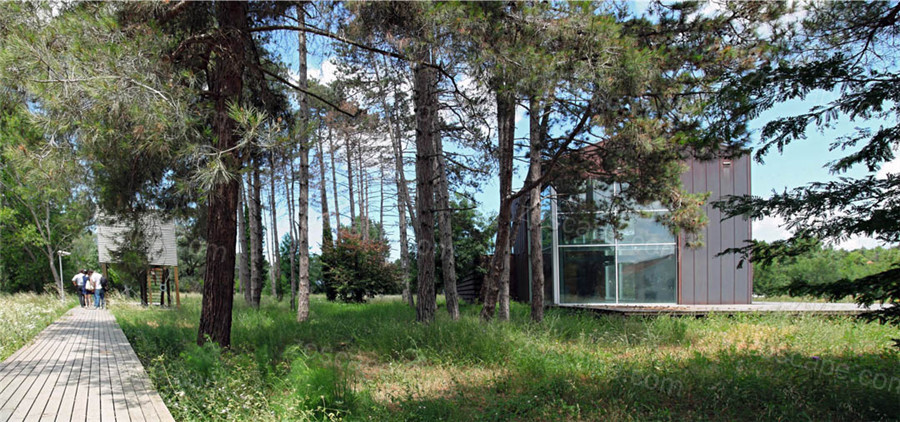Project Name: 伊斯坦布尔Terkos水技术博物馆生态湿地景观 Location: 伊斯坦布尔 Project Type:滨水生态湿地景观设计 生态景观改造设计 Key words: 滨水景观 滨水设计 滨水湿地 滨水景观设计 滨水绿地 滨水水库景观 城市滨水景观 滨水绿地景观 滨水滨江 滨水 滨水规划 生态湿地 湿地景观 滨水湿地 湿地景观设计 All photos :© DS Landscape 文字/翻译zoscape |
' J) I! C( L: J$ ]7 ?- |# J/ p" `) T. I# |
( L8 k' x# C5 E) y, }4 Q
伊斯坦布尔的Terkos抽水站在工作百年后结束使命,改头换面成水技术博物馆。伊斯坦布尔Terkos水技术博物馆生态湿地因地处Terkos湖区,这里有着特色的动植物群,是伊斯坦布尔重要的生态区。因此在作为谁技术博物馆的同时,伊斯坦布尔Terkos水技术博物馆开放的周边区域转化为娱乐区域,并也期望同时恢复被破坏的湿地生态系统。% p! H& W0 B2 @ U
/ n) q6 _1 ?" |, V2 C0 n* l0 J1 Z0 B& |8 [6 C- N1 C# E
/ H! J2 Z e" c
8 h* Z* R8 i0 f+ w4 p
% n, H$ m6 ]) J( ETerkos Pumping Station, which was the source to accommodate Istanbul's drinking water demands for over a hundred years, has lost its function and was repurposed as a water technologies museum. Terkos Lake and its surroundings, with its distinctive flora and fauna, still hold the position of being one of the most important ecological areas in Istanbul.The station is located in Çatalca and the total area of the project is 83.000 .0m². The total are of open space is 64.000 .0m².
, V+ X; z/ ~! m) j' K! L; ?
" g: Y' Q8 p) ?* r. o e. R* v* S& J( M9 L0 K2 B: M# v
" k/ U; k( v9 [' B/ A2 A: {7 F
' Y8 D: o5 K3 H/ S$ g8 l6 @+ g
4 F) t/ ?: s4 u, l/ i: Q3 ?' M伊斯坦布尔Terkos水技术博物馆生态湿地的水位在冬季会上升,因此人行道被抬高,以保证冬季能够使用。沿着人行道,插入各种景观要素,建立起参观者与生境的联系,强化对生态的认知。伊斯坦布尔Terkos水技术博物馆生态湿地的码头,露台,观测塔等各种形式的功能区,使得人们再次停留休息的同时可以有各种视点和角度来观察鸟类和生物。利落但是微小克制的介入,使得这个伊斯坦布尔Terkos水技术博物馆生态湿地联系博物馆与自然的项目最大化的促进生态系统的恢复。
" R- s0 Z/ M; {# x, r g, |
1 F8 R* ~/ Q# A! s伊斯坦布尔Terkos水技术博物馆生态湿地湖景
3 `& F2 A8 U/ i4 k+ ]6 E e
7 l/ ~- L! _. P7 T伊斯坦布尔Terkos水技术博物馆生态湿地景观道 , [; N2 }, }$ R; T: B3 J# y# F8 R' I
& n! T) L3 Q! H5 j
The varying connection every visitor from every age group makes with the element of water was established through the creation of stopping-resting-viewing points that embraces different flora and topography interactions all through the area, as well as the development and perception of the entire area in the concept of an ecological park. The walkways contribute to the visitor's experience of perceiving the areaas a whole. They transform into elements of design that fortify the connection with water by forming piers and terraces on spots where they come near the water during their entering and exiting of different natural fragments. The observation towers that are attached to these spots not only create a place for surveillance of water birds and bird immigrations while offering special perspectives and exposures, they also provide visitors with areas to stop and spend time in.
9 J) X" U# _" f n- ^1 d9 {
5 C) Z5 y: b) A- M: K
" g% M8 a8 x- S7 K; }Terkos水技术博物馆生态湿地景观路与建筑以及入口关系
% _4 U% A% v- h& a9 N! l' \
. c h/ I) S& U& I" Z' T! hTerkos水技术博物馆生态湿地季相景观
$ n9 B2 J2 p0 L1 A3 v5 q3 b2 v3 D5 r
 # v4 g. v: L$ D0 p
# v4 g. v: L$ D0 p
6 f' |1 B4 i. `4 h* D
0 P4 R0 A2 M( p9 o# @2 j
|